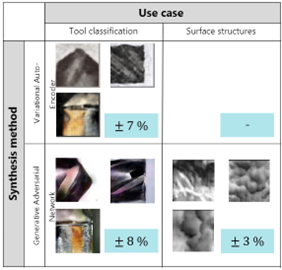
The project explored image data synthesis using Generative Adversarial Networks and Variational Autoencoders for machine learning in manufacturing, focusing on tool and surface structure classification. Synthetically generated data, when added to original datasets, sometimes improved classification performance. The effectiveness of synthetic data varied with the task complexity and synthesis parameters and was not always superior to traditional augmentation methods like rotation and flipping. The synthesis techniques were also made accessible via a web service.
| Topic Fields | |
| Published | 2023 |
| Involved Institutes | |
| Project Type | ICNAP Research/Transfer Project |
| Result Type | |
| Responsibles |
In this project, we researched, deployed, and evaluated approaches to image data synthesis for machine learning systems in manufacturing for suitability and potential. These approaches were implemented for two use cases: tool classification and classification of surface structures after laser polishing. The established approaches were also implemented in a web service, which allows users to perform data synthesis based on a provided image dataset.
Generative Adversial Networks and Variational Autoencoders were implemented and evaluated as SOTA approaches within the use cases. The quality of the synthetically generated data was evaluated in a use case-specific approach, by enriching the original dataset using synthetic data and evaluating a classification model trained on the modified dataset. Depending on the use case, significant improvements of the classification performance could be achieved by using synthetic data (see Figure 1). However, improvements compared to conventional methods of augmentation (e.g., image rotation and flipping) did not show in all experiments and strongly depended on the complexity of the classification as well as the parameterization of the method for synthesis.
Contact us to get in touch! With a membership, you’ll gain full access to all project information and updates.
© Fraunhofer 2025